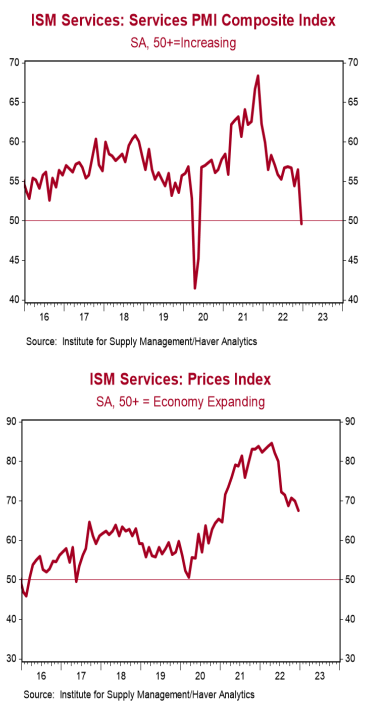- The ISM Non-Manufacturing index increased to 55.2 in January, well above the consensus expected 50.5 (Levels above 50 signal expansion; levels below signal contraction.)
- The major measures of activity were all higher in January. The new orders index increased to 60.4 from 45.2, while the business activity index rose to 60.4 from 53.5. The employment index increased to 50.0 from 49.4, while the supplier deliveries index rose to 50.0 from 48.5.
- The prices paid index ticked down to 67.8 in January from 68.1 in December.
Implications:
The ISM Services index surprised sharply to the upside for January, rebounding from contraction territory (below 50) in December by posting the largest monthly increase (besides the COVID reopening month) since records began in 1997. The rise was driven by new orders and business activity, which both surged to 60.4. Meanwhile, the categories for employment and supplier deliveries both rose to 50.0, signaling no change in jobs or production bottlenecks. Respondent comments in January were largely positive, citing strong demand and a cautiously optimistic growth outlook for 2023. Finally, the prices paid index ticked down to a still very elevated 67.8. While that is well below its peak from early 2022 – make no mistake – inflation is still a major problem in the service sector, with fifteen out of eighteen industries reporting paying higher prices. We expect the service sector to keep inflation trending well above the Fed’s 2.0% target for some time. Comparing the two January ISM reports, it’s clear that businesses and consumers are shifting resources away from goods and toward the service sector. While the service sector does not appear to be there yet, we believe the US economy will enter a recession in 2023. A handful of reports like industrial production, retail sales, and M2 suggest we could be already there, although today’s reports muddy that picture. We continue to think equity investors should be cautious. One thing we are certain about; there is no such thing as a free lunch. Eventually, the bill for the massive artificial stimulus in 2020-21 will come due.





